




On November 18, 2025, a major disruption rippled across the internet when Cloudflare—one of the world’s most widely used internet infrastructure providers—experienced a significant service outage. Because Cloudflare supports millions of websites with DNS, CDN caching, traffic filtering, API routing, and security layers, even a single malfunction can create global-level instability. And that’s exactly what millions of users witnessed that day: slow loading pages, apps refusing to open, authentication failures, and entire platforms temporarily unreachable.
While outages are not new in the digital world, this one stood out because of how deeply Cloudflare sits in the modern connectivity pipeline. In many ways, the incident offered a real-world reminder of how much of the internet relies on a few key infrastructure players.

According to Cloudflare’s engineering investigation, the root cause was a faulty internal configuration deployed to part of their network. This configuration affected a critical service responsible for evaluating incoming requests and filtering harmful traffic. When the service encountered the corrupted configuration file, it failed in a “closed” state—meaning instead of allowing traffic through when uncertain, it blocked it.
This resulted in a surge of HTTP 5XX errors, especially 500 and 503 responses, which are typical indicators of server-side failures. Users around the world soon realized that websites using Cloudflare were timing out, stalling, or redirecting to error pages.
Unlike outages caused by connectivity failures or cyberattacks, this event was self-inflicted by a software deployment that didn’t behave as expected. Small configuration issues can have an outsized impact in distributed systems, and this incident highlighted how even a single misconfiguration in a shared global network can cascade quickly.
When Cloudflare pushed the problematic update, only part of the network received it at first. This meant some nodes were functioning normally while others were rejecting legitimate requests. As traffic routing systems attempted to balance loads across these nodes, users received unpredictable experiences—one moment a service worked, the next it failed.
This “flapping” behavior created instability until Cloudflare engineers isolated the issue, rolled back the configuration, and restored normal operations. Because Cloudflare’s infrastructure is interconnected, the rollback had to be done carefully to avoid further disruptions.
The outage lasted several hours for some regions, though others recovered sooner depending on local routing and DNS propagation.
The disruption was widely felt because Cloudflare isn’t simply a website host—it acts as a performance booster, security layer, and traffic gateway for businesses large and small. Popular platforms relying on Cloudflare for DNS or CDN saw sudden performance drops. E-commerce portals, SaaS dashboards, streaming services, and even mobile apps that depend on API calls struggled to function.
For many businesses, this meant:
Even organizations that had redundant hosting infrastructure were affected if they used Cloudflare for routing or DNS resolution.
Although Cloudflare increases performance and security for millions of websites, the outage showed how a single point of failure can disrupt a huge portion of online activity. Centralization offers efficiency but also creates vulnerability.
Many companies invest in multi-cloud or backup environments, but rely on a single provider for DNS or CDN. The outage highlighted why redundancy must cover every layer of the stack, including traffic routing and security services—not just compute resources.
Modern cloud platforms are highly automated, but that also means configuration errors can spread extremely fast. Even with safety checks, edge cases slip through. The best protection is layered testing, staged rollouts, and real-time anomaly detection.
Cloudflare acted quickly, pausing the rollout and identifying the failing component. Engineers issued a rollback, restarted affected services, and published a transparent incident update. Their communication emphasized that the issue was not caused by an attack, but by an internal logic failure during deployment.
The company also announced improvements to configuration validation, emphasizing stronger safeguards to prevent similar issues in the future.
The November 2025 outage is a valuable case study for businesses that rely heavily on cloud-based traffic tools:
Most importantly, organizations must acknowledge that outages are inevitable. The real question is how resilient the architecture remains when a critical provider becomes unavailable.
The Cloudflare outage of November 18, 2025 was a reminder of the complexity and fragility of the internet’s backbone. While Cloudflare resolved the issue efficiently and transparently, the event highlighted how interconnected digital services have become.
While ISPs cannot protect themselves from technical issues with the Internet, they can definitely adopt tools that strengthen operational visibility and fault management. Jaze ISP Manager provides powerful helpdesk and task management features to help teams detect and respond to internal outages faster.
The Internet today works much like a vast and rapidly expanding city. Every device — whether it’s your phone, laptop, or home router — needs a unique address to send and receive information. For decades, this addressing system depended on IPv4, a 32-bit structure that was perfectly adequate when the Internet was small.
However, as more people, devices, and services connected online, IPv4’s supply of addresses could no longer keep up with the growth. This shortage triggered the introduction of temporary workarounds and long-term solutions — the most significant being Carrier-Grade NAT (CGNAT) and IPv6.
To extend the lifespan of IPv4, many Internet Service Providers (ISPs) adopted Carrier-Grade NAT. Instead of assigning every user a unique public IP address, CGNAT enables multiple customers to share a single IP. Each household receives a private internal address, and a translation layer maps internal traffic to the shared public IP.
This approach successfully delayed IPv4 exhaustion, but it introduced several limitations. CGNAT disrupts the Internet’s original end-to-end communication model by placing translation devices in the middle of user connections. As a consequence, certain applications struggle to function correctly, especially those that rely on direct connectivity.
Port forwarding becomes extremely difficult, sometimes impossible. This affects use cases such as home servers, online gaming, peer-to-peer applications, remote access setups, and more. Additionally, when multiple users share the same public IP, identifying the source of spam, abuse, or cyberattacks becomes far more complex. These challenges make CGNAT a useful but imperfect solution.
IPv6 was created as a permanent and future-proof alternative to IPv4. With its 128-bit address space, IPv6 provides an enormous pool of unique public addresses — enough for every device on Earth and many more.
Unlike CGNAT-based IPv4 setups, IPv6 supports true end-to-end connectivity. Every device can be globally reachable without relying on NAT layers or port mapping workarounds. This leads to cleaner network designs, lower complexity, improved reliability, and better performance for applications that require direct communication.
Despite its advantages, IPv6 adoption has been slower than expected. Many networks still run primarily on IPv4 infrastructure, and not all devices or applications fully support IPv6. In some cases, IPv6 is deployed using the same philosophies as IPv4 NAT, reducing the benefits of the protocol due to outdated design assumptions.
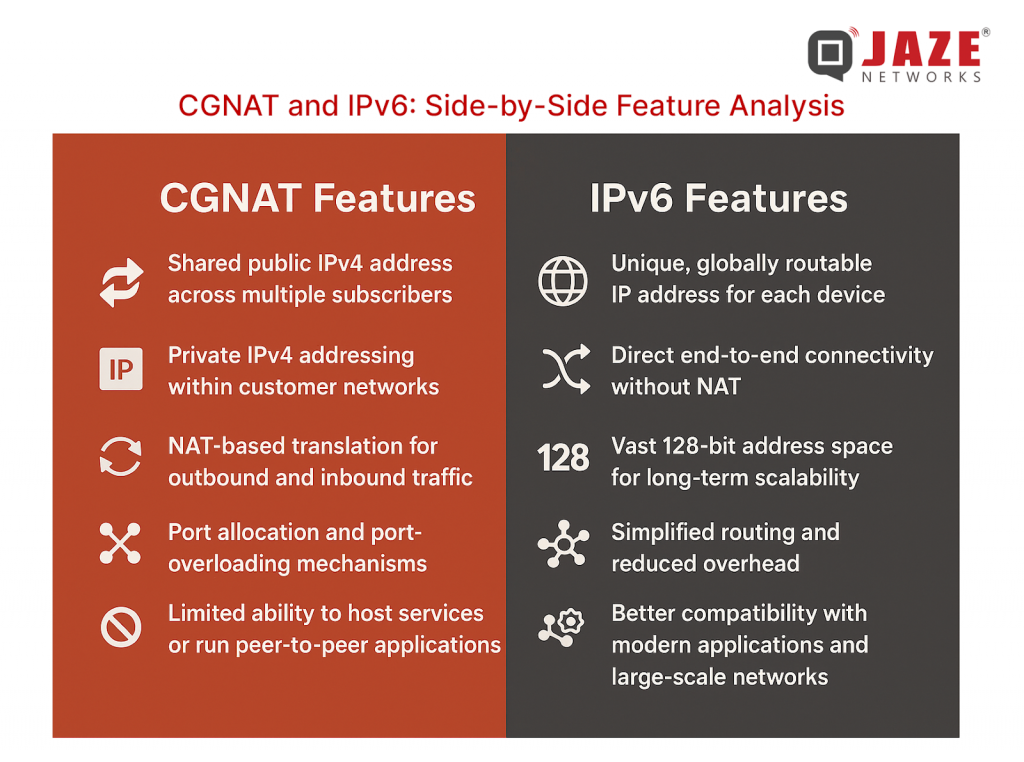
The differences between CGNAT and IPv6 become clear when examining common real-world scenarios:
In essence, CGNAT introduces friction for modern, interactive Internet use cases, while IPv6 aligns naturally with today’s connectivity needs.
Migrating an entire global Internet ecosystem is complex. Several factors slow down IPv6 deployment:
To move forward, ISPs must embrace native IPv6 routing instead of leaning on NAT-based stopgaps. Device manufacturers and service providers should treat IPv6 compatibility as mandatory, not optional. Developers and technical professionals need to adopt IPv6-first design principles to ensure smooth interoperability.
CGNAT has played an important role in extending the life of IPv4, but its limitations are increasingly apparent. It complicates connectivity, affects performance, reduces transparency, and restricts how users interact with the Internet.
IPv6, by contrast, provides scalability, efficiency, and true end-to-end communication — all essential for the modern digital ecosystem. While the transition is ongoing, IPv6 represents the Internet’s long-term foundation.
For users who rely on hosting, gaming, remote access, or advanced networking features, choosing an ISP that offers robust, native IPv6 routing can significantly improve their experience. For technology creators and providers, adopting IPv6-first development ensures long-term compatibility and reliability.
Ultimately, the future of the Internet is built on abundant addressing, simplified routing, and open connectivity — the principles that IPv6 was designed to deliver.
Jaze ISP Manager offers comprehensive solutions to help ISPs transition seamlessly to IPv6 with integration with all major BNG providers ensuring robust network performance and future-proof connectivity.
API (Application Programming Interface) integration allows different software applications to exchange information seamlessly—and that matters a lot for Internet Service Providers (ISPs).
Consider this scenario: A new subscriber signs up via your mobile app, their account is created in your billing system, the network gateway provisions their service, and the CRM logs the sale—all in real time. Without API integration, this flow involves manual steps, delays, errors, and lots of overhead. With it, everything happens automatically.
For ISPs, that means faster onboarding, fewer customer issues, lower operational costs, and better scalability. As access technologies diversify (fiber, WiFi 6/7, fixed-wireless, IPTV, OTT), the number of connected systems grows—but so does the need for smooth, automated data flow. API integration isn’t just “nice to have”—it’s a competitive necessity.

At its simplest: application A sends a request, application B responds. Under the hood, there are a few key elements:
In practical terms for ISPs: your customer portal might call an API to create a subscriber record; your billing engine might call another API to update plan status; your network controller might call an API to configure network access. Each of these steps is automated and connected.
For ISPs, choosing the right method depends on scale, variety of systems, and how fast you need to move. As your ecosystem grows (multiple access types, value-added services, OTT bundles), an iPaaS-style approach tends to make the most sense.
API integrations offer a wide range of benefits—here are some key use cases:
Delayed or fragmented integrations cost ISPs far more than just slow processes. They cost growth, customer satisfaction, and innovation. In today’s broadband-hungry world, seamless API integration is no longer optional—it’s mission-critical.
If you’re an ISP looking to scale, diversify services, and reduce operational overhead, make API integration a key pillar of your strategy. It’s the connective tissue that lets all your tools—billing, network, CRM, OTT, payments—work as one.

Click here to learn more.
The broadband era has surged ahead. With streaming, IoT, remote work and fixed-wireless access all increasing, the role of the Broadband Network Gateway (BNG) is more critical than ever. What used to be a fairly straightforward gateway for customer broadband access is now the core pivot in ISP networks — managing subscriber sessions, enforcing policy, enabling new services.
As ISPs and software providers look ahead, it’s timely to review how BNG access models are evolving — what the new models are, why they matter, and what to consider when redefining your architecture.

Older BNG architectures were largely built around these characteristics:
However, several shifts are making this traditional model less effective:
Because of this, ISPs must rethink the BNG — the access model, deployment location, and software vs hardware trade-offs.
Here are several access models emerging in the BNG space — useful to understand for product positioning, network architecture or software service strategy:
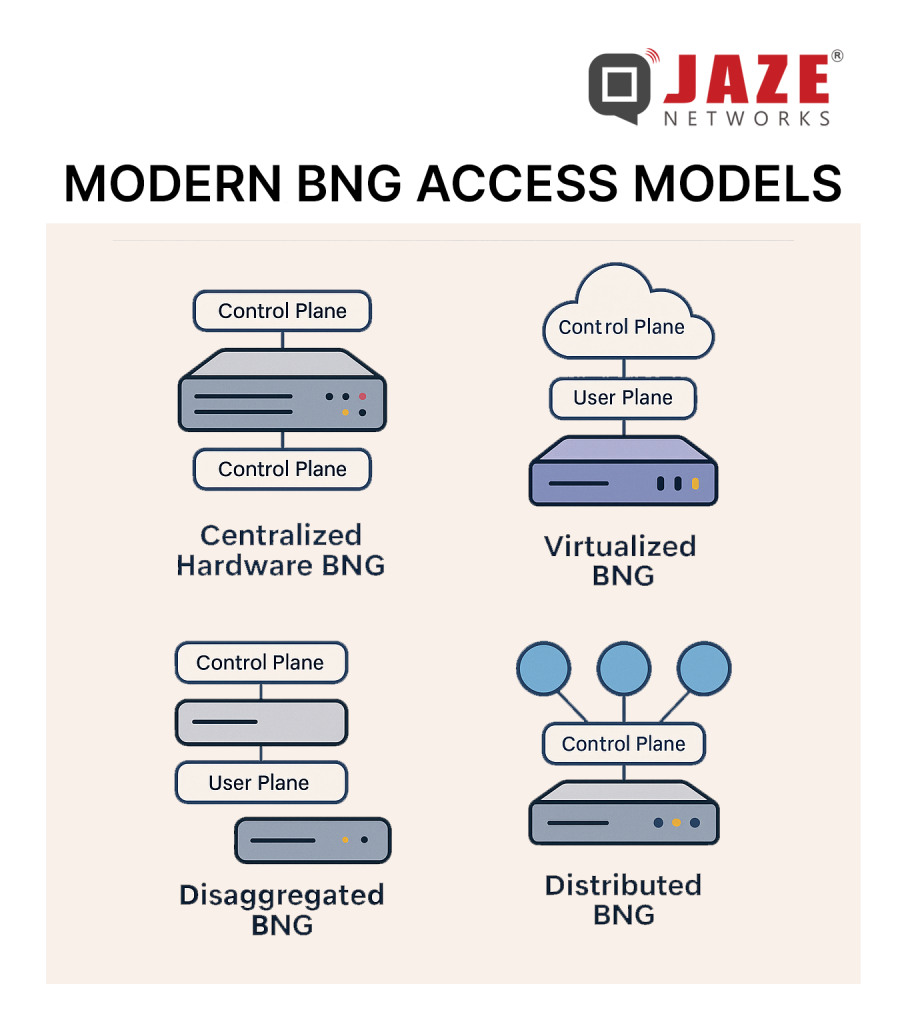
From the vantage of an ISP or a software vendor for ISPs, understanding these access models gives you strategic insight:
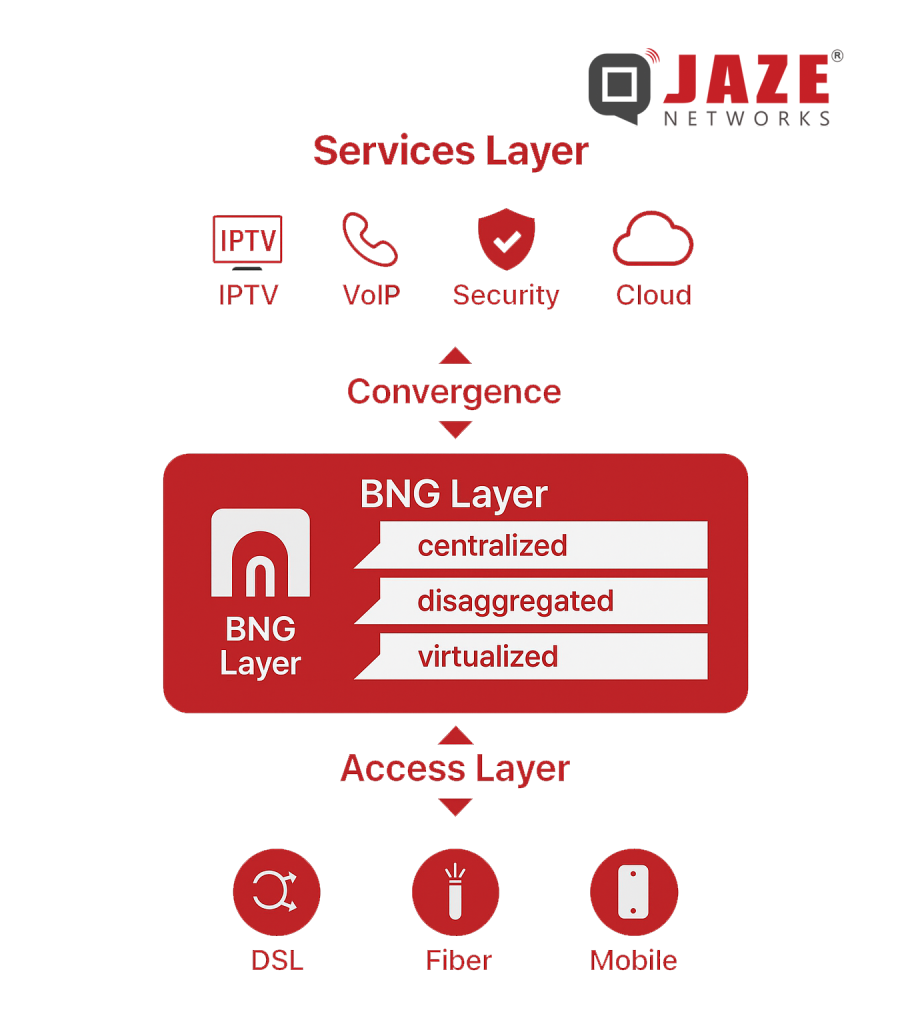
Cost efficiency & scalability: Virtualised/disaggregated BNGs reduce hardware dependency, enable scaling with demand, lower OPEX.
Service agility: Faster introduction of new pricing tiers, service bundles, new access types (FWA, WiFi) — software control matters.
Operational simplicity: Central control plane means fewer edge-appliances to manage; disaggregation means upgrades, scaling becomes less disruptive.
Edge performance & user experience: With distributed user plane, latency and backhaul loads are reduced, supporting high-quality real-time services.
Convergence & future-proofing: Fixed + wireless + multi-access handled by common architecture means ISPs are better positioned for 5G, IoT, edge-services.
Here’s a quick checklist for ISPs and software vendors to assess their BNG strategy:
Subscriber scale & growth: Can the model scale out linearly with subscriber growth and traffic loads?
Access diversity: Will your access types (fiber, FWA, WiFi) be supported under the model?
Control vs user plane location: How decoupled are they? Where will user plane be located for optimal performance?
Software orchestration & automation: Are provisioning, policy, subscriber lifecycle fully automated?
Service agility: How quickly can new tariff plans, bundles, access services be introduced?
Hardware dependency: What is the capex/opex trade-off? Can you move toward software-defined alternatives?
Edge readiness & latency: If you support real-time or OTT services, is your user plane close enough to the edge?
Vendor ecosystem & integration: Does the solution support open interfaces, multi-vendor, easier upgrades?
Whether you go for a centralised appliance, a virtualised cloud-native gateway, a disaggregated CUPS architecture or an edge-distributed model — the common theme is flexibility, software-first, multi-access readiness and subscriber-centric policy control. For ISPs and the SaaS companies that serve them, aligning your strategy (and your software platform) with these modern BNG access models means you’re not just keeping up — you’re positioning for next-gen broadband services, better user experience and operational advantage.
Jaze ISP Manager offers seamless integration with leading BNG/BRAS platforms — enabling ISPs to manage subscriber sessions, enforce policy across all access types, automate provisioning and billing, and monitor network health from one unified dashboard. Whether you are operating a traditional hardware BNG, moving to virtualised models or adopting a distributed edge architecture, Jaze ISP Manager supports the full lifecycle: from onboarding to churn, with scalability built in.
Click here to learn more.
When we talk about internet speed, most people instantly think about how fast they can download movies, stream videos, or browse social media. But in today’s world, it’s not just about downloading anymore — upload speed is equally important.
As we step into 2025–2026, when remote work, cloud storage, video creation, and smart devices dominate daily life, upload speed can make or break your digital experience.
Let’s understand why it matters — and how it affects almost everything you do online.
What Exactly Is Upload Speed?
Upload speed refers to how quickly you can send data from your device to the internet.
It’s measured in megabits per second (Mbps), just like download speed.
Every time you:
—you’re using your upload bandwidth.
If your upload speed is low, even a strong download connection can feel sluggish or unstable during these tasks.
1. The Era of Remote Work & Online Collaboration
Work-from-home and hybrid models are here to stay. Every video meeting, shared file, or cloud document relies on your upload connection.
A slow upload speed means blurry video calls, lagging audio, and constant “reconnecting…” messages — not ideal when you’re presenting to clients or attending classes online.
2. Social Media & Content Creation Boom
From influencers to small business owners, everyone is uploading photos, reels, and videos daily.
With 4K and 8K becoming standard, files are huge. High upload speed ensures your videos go live faster — and without frustrating delays.
3. Cloud Storage & Backup
We’re moving away from storing everything on devices. Automatic backups to Google Photos, iCloud, and OneDrive constantly use upload bandwidth.
If upload speeds are low, backups slow down, sync fails, and your data may remain outdated.
4. Smart Homes & IoT Devices
Cameras, sensors, and voice assistants send continuous data to cloud servers.
When upload bandwidth is insufficient, you’ll see camera feed delays, failed device syncs, or unreliable smart automation.
5. Gaming & Live Streaming
Gamers know the pain of lag.Online gaming and live streaming both rely on strong upstream connections — every action, every frame, every voice chat goes out through your upload channel.
Higher upload speeds mean smoother gameplay and crystal-clear streams.
| Online Activity | Recommended Upload Speed |
| Video calls (Zoom, Meet) | 3–5 Mbps |
| Cloud backups | 10–20 Mbps |
| Online gaming | 5–10 Mbps |
| 4K live streaming | 20–25 Mbps |
| Uploading large media files | 25 Mbps and above |
If multiple devices or users share the same connection, you’ll need even higher speeds for a seamless experience.
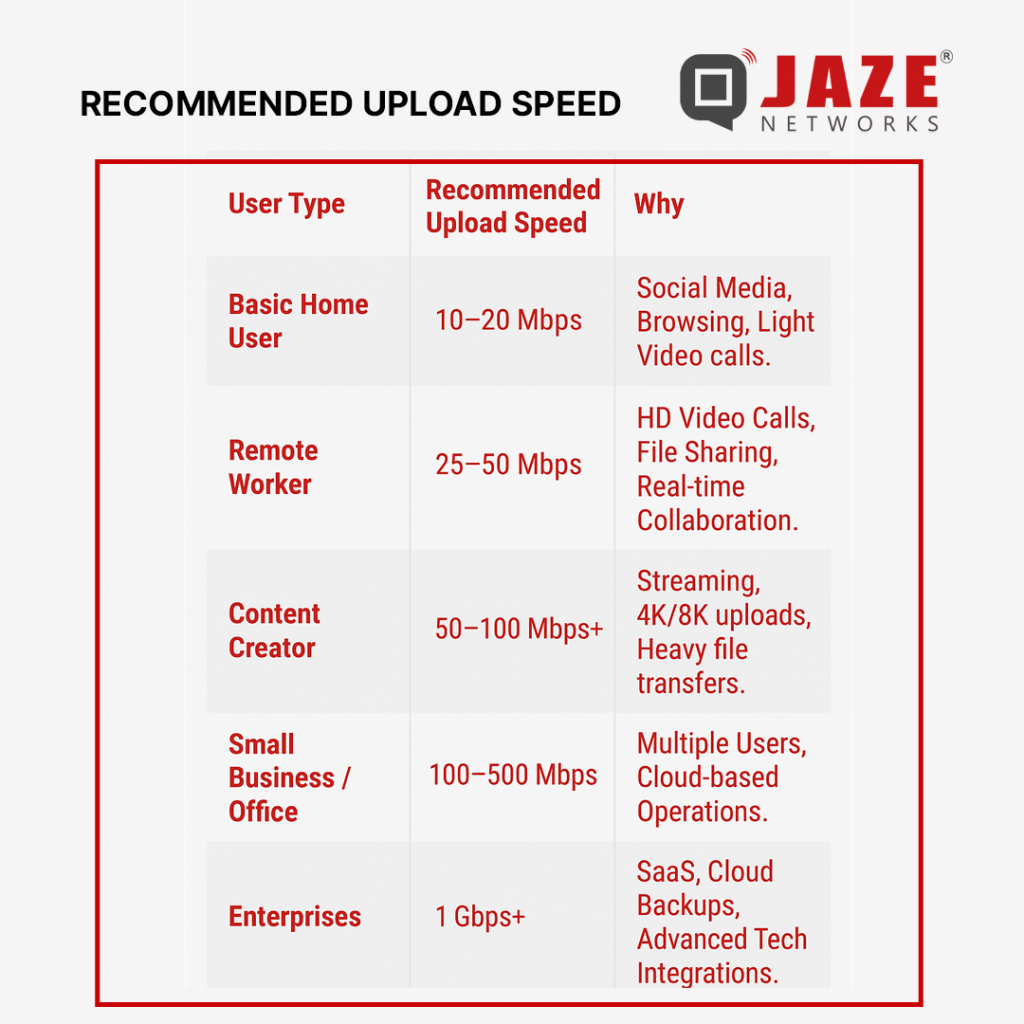
India’s internet usage pattern is shifting fast. Earlier, most users were consumers of content — watching, downloading, or streaming.
But now, millions are creators — students uploading projects, professionals hosting webinars, and entrepreneurs managing online stores.
Unfortunately, many broadband plans in India still prioritize download speeds and offer much lower uploads (often just 10–20% of download rates).
That imbalance is slowly changing, as fiber networks and symmetrical connections become mainstream.
Traditional broadband (like copper or DSL) can’t handle equal upload and download speeds.
But fiber-to-the-home (FTTH) connections deliver symmetrical speeds — meaning if you get 200 Mbps download, you also get 200 Mbps upload.
This makes a huge difference for:
Fiber technology is the backbone of India’s digital growth — and it’s finally bridging the upload gap.
As India embraces a creator-driven digital economy, upload speed is no longer secondary — it’s essential.
Whether you’re working from home, managing an online business, or sharing your creativity with the world, faster upload speeds ensure smoother, smarter, and more reliable connectivity.
Jaze ISP Manager helps ISPs by optimising bandwidth delivery and provide a seamless experience to subscribers. This ensures stable upload speeds for users, reduces congestion during peak hours, and improves performance for video calls, cloud backups, and live streaming. In short, it gives ISPs the tools to maintain reliable upstream performance for their customers. Click here to know more
Real-Time Communications (RTC) — whether video conferencing, live streaming, or VoIP — have become the backbone of modern connectivity. Users expect instant, uninterrupted interaction, and even minor delays can cause frustration. Delivering this level of performance requires more than just fast internet; it relies on understanding Quality of Service (QoS) and Quality of Experience (QoE), and how they intersect.
Quality of Service (QoS) is the technical engine that ensures RTC traffic moves efficiently across networks. Without it, calls drop, video lags, and user frustration rises.
Key QoS mechanisms include:
By controlling these network variables, QoS provides measurable reliability — the foundation for any RTC application.
While QoS handles the network, Quality of Experience (QoE) focuses on how users perceive the service. High network performance doesn’t automatically translate into a satisfying experience if the application is difficult to use or inconsistent.
Factors affecting QoE include:
Measuring QoE often involves subjective feedback, such as Mean Opinion Scores (MOS), surveys, or session success rates.
The most successful RTC experiences occur when QoS and QoE are aligned. Network optimizations (QoS) set the stage, but user perception (QoE) determines satisfaction.
For instance, a video conference may have excellent packet delivery, low latency, and zero jitter — but if users struggle to navigate the app or experience confusing error messages, QoE suffers.
Integrated monitoring of both QoS metrics (latency, jitter, packet loss) and QoE indicators (MOS, user engagement) allows providers to proactively identify problems and enhance the overall experience.

Monitoring the right metrics helps bridge technical performance and user satisfaction:
QoS Metrics:
QoE Metrics:
Tracking both sets of metrics ensures service providers can pinpoint issues, whether technical or user-facing.
These strategies provide measurable improvements in both technical performance and user satisfaction.
In a digital-first world, RTC performance can make or break user experiences. QoS ensures the network can deliver real-time data reliably, while QoE measures the perception and satisfaction of the user. Service providers who monitor, optimize, and balance both aspects will not only prevent disruptions but also build trust and loyalty among their users.
Investing in QoS and QoE is not optional — it’s the foundation for RTC success, whether in business, education, or everyday social interactions.
Jaze ISP Manager becomes critical in this equation. In integration with BNG providers, Jaze ISP Manager automates enforcement of intelligent traffic policies, and provides real-time analytics, empowering ISPs to deliver consistent QoS while keeping QoE at the center. The result: seamless RTC experiences, satisfied subscribers, and a future-ready network that scales effortlessly with demand.
Internet Service Providers (ISPs) and enterprises face mounting pressure to secure their networks while ensuring seamless user experiences in the fast-paced digital era. The Authentication, Authorization, and Accounting (AAA) framework provides a structured approach to manage network access, prevent misuse, and maintain compliance.
AAA stands for:
Together, these three processes create a reliable system that ensures only the right people get the right level of access—while all activities are logged for accountability.
Unauthorized access can lead to service abuse, downtime, and regulatory risks. AAA protocols ensure only verified users connect to the network, reducing threats from both external attackers and internal misuse.
With authorization policies, ISPs can assign access levels based on roles—customers, staff, or partners—ensuring sensitive systems remain protected.
Accounting helps providers monitor how network resources are used. For ISPs, this is especially valuable for bandwidth management, billing accuracy, and detecting unusual traffic spikes.
Governments and regulators demand traceability of network activity. Accounting logs serve as digital evidence to meet compliance requirements and reassure customers about data security.
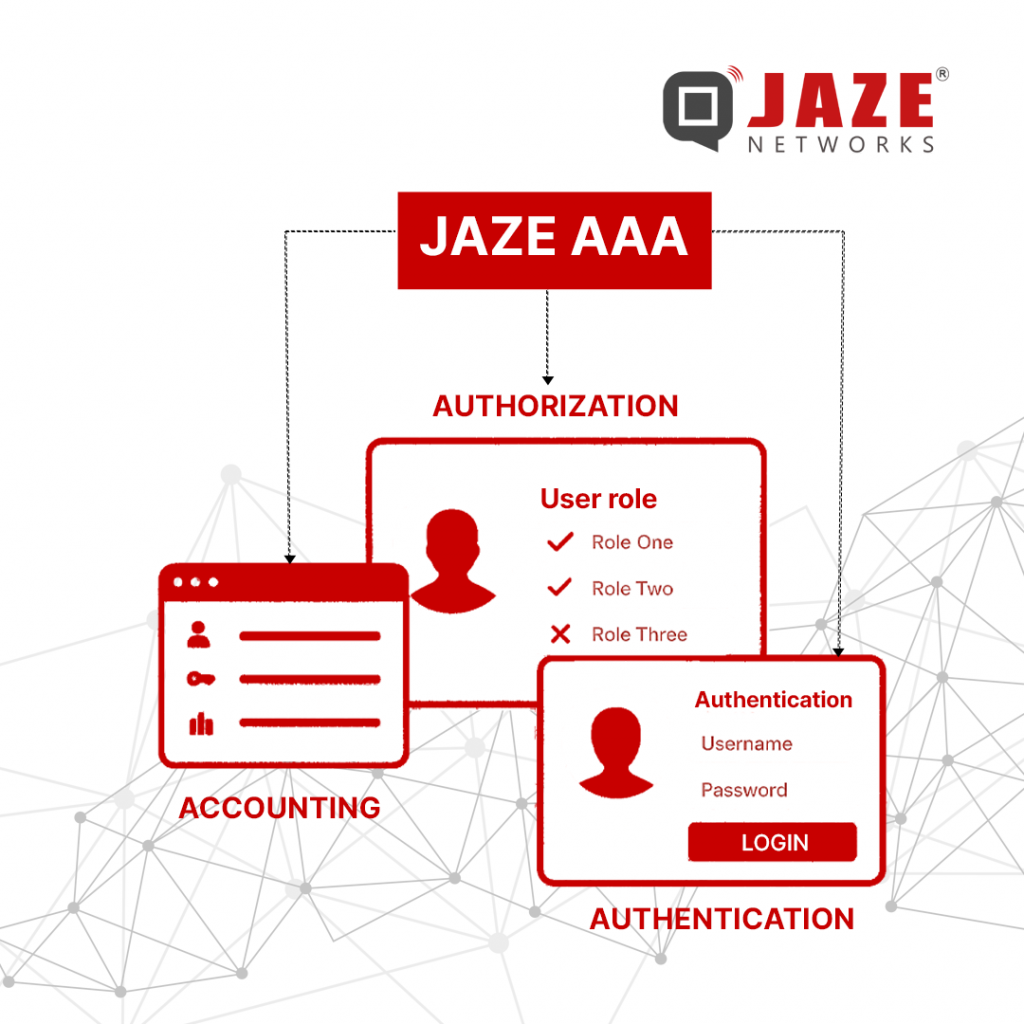
Different protocols implement AAA in unique ways. Here are the most widely adopted:
For ISPs and large businesses, a well-structured AAA setup is critical. The implementation usually involves:
To get the most out of AAA frameworks, operators should:
As ISPs expand services into fiber, 5G, and enterprise networking, the demand for scalable, automated AAA systems will only grow. Cloud-native AAA platforms are already emerging, offering flexibility and real-time policy enforcement across distributed infrastructures.
For ISPs and enterprises alike, AAA is no longer optional—it’s the foundation of secure, reliable, and accountable network access. By choosing the right protocols, enforcing strong access policies, and embracing best practices, operators can strengthen security, streamline operations, and build customer trust.
Jaze ISP Manager delivers carrier-grade AAA with centralized authentication, authorization, and accounting to secure broadband, enterprise, and public access networks. It integrates seamlessly with RADIUS and TACACS+ for subscriber management and device administration across distributed infrastructures.
ISPs can enforce role-based access policies, streamline user onboarding, and ensure compliance with regulatory requirements. Built-in redundancy guarantees high availability, while real-time accounting provides transparency for usage, billing, and auditing. By combining automation with AAA architecture, Jaze enables operators to deliver uninterrupted connectivity, faster troubleshooting, and reliable service at scale.
Click here to know more
India’s digital transformation has been one of the most significant global stories of the past decade. With over 820 million internet users, the country has emerged as a digital-native economy, despite having a GDP per capita of just over $2,700. While many countries transitioned gradually from desktops to smartphones, India skipped a few steps—embracing mobile-first access from the start.
This shift isn’t just about personal connectivity—it’s reshaping how industries operate, especially the business events sector. To stay relevant and future-ready, industry players must understand the implications of India’s digital adoption and build strategies around it.
India’s digital growth is powered by affordable smartphones and low-cost data plans, making internet access more democratic and widespread.
This has created an environment where digital content, platforms, and tools are more relevant than traditional, hardware-intensive solutions.
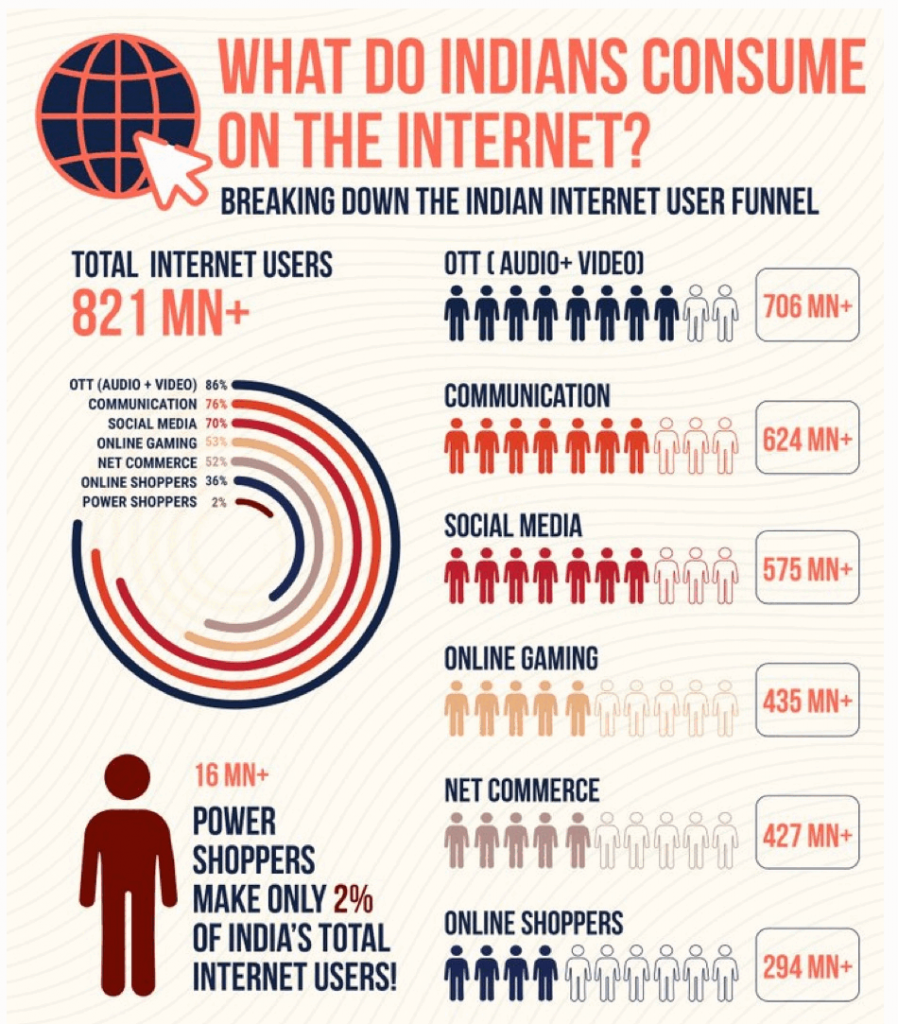
The nature of India’s digital access changes how audiences engage with content and events. Traditional formats no longer suffice. Instead, digital-first strategies must become central to event planning, marketing, and execution.
Here are three key ways the business events industry can evolve:
Event organisers must think beyond the physical venue. With millions of people accessing content via mobile phones, the potential reach is enormous—if content is tailored and distributed effectively.
Modern venues must support more than Wi-Fi. They need to enable seamless content creation, hybrid streaming, and sustainable practices powered by digital infrastructure.
Vendors—whether tech providers, production partners, or logistics firms—play a crucial role in helping organisers and venues bridge the digital gap.
To build an inclusive, sustainable events industry in India, stakeholders must experiment with digital technologies at every level—from promotion and operations to post-event analysis.
India’s digital-first population presents an incredible opportunity—but only for those prepared to adapt. Organisers, venues, and vendors must rethink their roles and responsibilities in a mobile-led world. By embracing digital tools, supporting inclusive infrastructure, and prioritizing sustainability, the business events industry can truly evolve to serve India’s next billion internet users.
As digital connectivity becomes central to every industry, Internet Service Providers must modernize how they operate.
Jaze ISP Manager helps ISPs manage their broadband business with ease—offering automated customer support, real-time network monitoring, intelligent fault detection, and direct revenue sharing between franchises. It’s a complete solution designed to improve reliability, simplify operations, and support scale, especially in mobile-first markets like India.
Click here to know more.
In an era where streaming, video conferencing, and real-time gaming dominate digital activity, most users still equate better internet with higher bandwidth. But the real indicators of network quality lie deeper—in factors like latency, jitter, and bufferbloat. Understanding these metrics is essential to achieving consistent, high-quality connectivity.
While bandwidth defines the maximum data transfer capacity, it doesn’t ensure consistent delivery. Think of bandwidth as the width of a pipe, not the speed or smoothness of water flow. High bandwidth with unmanaged latency and jitter can still lead to poor Quality of Experience (QoE).
Latency measures the round-trip time data takes to travel between a device and a server. High latency creates noticeable delays, especially during:
Solution:
Jitter represents fluctuations in packet arrival times, which leads to data arriving out of sync. This is particularly disruptive for time-sensitive applications like:
Solution:
Bufferbloat occurs when network devices over-buffer packets, introducing delay and congestion even when bandwidth is not fully utilized.
Symptoms include:
Solution:
While a fast connection helps with large file downloads or 4K streaming, real-time communication depends more on network consistency than on raw speed.
Best Practices:
For ISPs and enterprise network managers, focusing solely on delivering higher speeds is no longer sufficient. Real competitive advantage lies in offering:
Maximizing internet performance isn’t about bandwidth alone. To truly optimize the end-user experience, network administrators and users alike must address the hidden factors—latency, jitter, and bufferbloat—that directly influence application responsiveness and reliability.
Investing in smarter infrastructure, performance-aware configurations, and end-to-end visibility will ultimately provide a smoother, faster, and more predictable network experience for all users.
To improve Quality of Experience (QoE) beyond just bandwidth, Jaze ISP Manager equips ISPs with meaningful insights into subscriber usage.
Jaze ISP manager in integration with BNG routers supporting FQ-CODEL based AQM helps to optimize the quality of experience effectively managing latency, jitter, and bufferbloat.
Click here to know more.
When your video call freezes or your online game lags, it’s tempting to blame insufficient bandwidth. However, the real culprits often lie elsewhere: latency, bufferbloat, and jitter. These factors significantly impact your Quality of Experience (QoE), often more so than raw bandwidth.
Think of bandwidth as the width of a highway. A larger highway allows more cars to travel at once, but it doesn’t determine how fast each car moves. Similarly, increasing bandwidth allows more data to flow, but if network conditions aren’t optimized, latency, bufferbloat, and jitter will still ruin your experience—whether you’re gaming, streaming, or on a video call.
If you’ve ever upgraded your internet and wondered why your Zoom calls still freeze or your online game still lags, you’ve been focusing on the wrong metric.
Latency measures the time taken for data to travel between devices. If you click a button in an online game, latency determines how long it takes before the action is reflected on screen. High latency causes lag, making games unplayable and video calls frustrating.
What affects latency?
Have you ever noticed that when someone in your household uploads a large file, everything else slows down? That’s bufferbloat at work. Routers often over-buffer data, causing massive delays for real-time traffic like video calls and gaming.
Imagine standing in line at a store while someone ahead of you loads up their cart with hundreds of items. You don’t get to the checkout any faster, even if the store has multiple lanes open. Similarly, bufferbloat clogs the network, making time-sensitive activities suffer.
A smart fix is Active Queue Management (AQM), which prioritizes real-time tasks over bulk transfers.
Jitter happens when data packets don’t arrive at regular intervals. Normally, packets should flow smoothly, but network congestion and interference can cause uneven delivery times, making audio sound robotic and video stutter.
For streaming, gaming, or calls, jitter is one of the most frustrating issues—even more disruptive than low bandwidth.
How do you fix jitter?
True internet performance isn’t just about bandwidth—it’s about controlling latency, bufferbloat, and jitter. The best way to improve QoE is to:
Next time someone says they have the fastest internet, ask them about their latency, bufferbloat, and jitter. Because in reality, the best QoE comes from optimizing delays—not just increasing bandwidth.
To enhance the Quality of Experience (QoE) beyond mere bandwidth considerations, Jaze ISP Manager offers a comprehensive suite of tools designed for Internet Service Providers. By providing detailed insights into subscriber usage patterns, it enables ISPs to make informed decisions that optimize network throughput and reduce latency in integration with BNG routers.
Additionally, Jaze ISP Manager supports prioritization of critical traffic, ensuring seamless user experiences and offers advanced traffic shaping capabilities, facilitating the implementation of Quality of Service policies that address latency, jitter, and bufferbloat. Click here to know more.